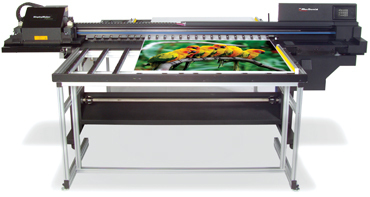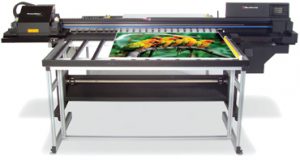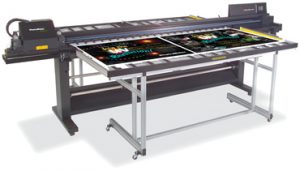Digital Printing
ColorSpan’s DisplayMaker 72UVX and 98UVX
Printing large at the speed of light
Published
17 years agoon

A true pioneer in large-format digital printing, MacDermid ColorSpan Inc., early on, bundled a RIP with its wide-format, inkjet printer to create one of the first digital-printing package systems. Often, such early players are steam-rolled by larger companies and, in time, are either absorbed or switched off. This usually happens when a company doesn’t manufacture its main components — here, printers — or they don’t stay current with technology trends. Or market demands.
Some years ago, MacDermid began making its own printers, and it has continued to innovate. Today, for example, it offers a robust line of UV-cure and solvent printers for outdoor-image applications.
Additionally, the company has studied its product buyers and discovered a serious demand for fast, production-grade printers. Some machine buyers, however, don’t have the money for industrial-grade machines. To satisfy them, ColorSpan offers lower-cost, reduced-specification systems, but with comparable quality and design features.
The DisplayMaker 72UVX and 98UVX complement its already comprehensive product line. These printers add speed and media flexibility to a proven platform, so if you’re looking for a production-grade printer capable of speed and cost-effective operation, read on.
Specifications
AdvertisementWe’re combining the two printers’ specifications because they’re virtually the same machine, except for the print width. Also, because ColorSpan has chosen an industrial aesthetic that emphasizes the printers’ structures, don’t expect plastic moldings that enhance the machines’ looks. Everything is metal; the lines are straight and clean.
A first glance reveals the printers can handle rigid materials.
A feed and take-up table system extends in front of and behind the printers. The table parts are solid. Touch them, and you’ll know these additions are heavy duty.
How big are these beasts? Let’s start with the 72UVX. Its dimensions, starting with height, are 52.5 3 33 3 133 in. The 98UVX’s measurements are the same, except its 159-in. width. The depth dimension doesn’t include the rigid-media tables. Because you’ll surely use this, account for an 87.7-in. depth when measuring for the workstation. Be sure to plan for materials-handling space on both ends of the printer. The lesser printer weighs 375 lbs., the larger 425 lbs. Add 125 lbs. for the rigid-media tables.
The stock table handles 5-ft. media lengths, but ColorSpan offers optional, table extensions that manage 10-ft.-long rigid media. Think about this if you often process a large amount of 4 3 8-ft. work.
AdvertisementBoth printers require 220 to 240 VAC, single-phase, 50/60Hz, 15-amp power; the operating temperature zone is 68° to 85° F with the non-condensing, relative humidity ranging between 20 and 80%.
The printers
Excepting dimensions and weight, both printers share the same specifications. First, let’s look at the printing widths. The name, 72UVX, translates to a printable-image width of 72.5 in. The 98UVX processes media widths up to 98.5 in. with a printable area 98 in. wide. Roll media needs .25-in. right and left margins, but both printers can perform edge-to-edge printing on rigid media. The printers can handle rigid-media thicknesses up to 0.5 in. (double the thickness the DisplayMaker 72UVR can support).
Printing technology
A quick refresher. UV printers produce outdoor- and UV-stable images. As opposed to air- or heat-cure solvent printing, UV uses high-intensity, UV lamps to cure (dry) the inks. No media coating is required, and the inks will stick to almost anything. When dry, UV ink doesn’t produce VOCs, and only ordinary, fan-driven, inlet and outlet venting is required in the workspace.
The UVX series of printers uses two, easily changed, UV lamps. You can also set the lamp intensity to low, medium or high, depending on your desired ink coverage.
AdvertisementColorSpan offers its SolaChrome, pigmented, UV-cure inks for the CMYK, UVX printers. It says the printed images can last up to two to three years outdoors. The ink comes in 3-liter (yes, we said 3-liter) sealed bottles — the size typical of industrial printers that cost $250,000 and up. The large ink capacities help reduce supply costs. ColorSpan says the ink cost for a 600-dpi image is less than 20 cents per square foot.
The UVX printers’ 16 piezo printheads (four per color) use Micro-Quad™ Jet Technology. The printheads are true/native 600 dpi, and the machines will produce images at 600 3 600 and 600 3 300 dpi.
In all, the mechanism includes more than 1,500 jets. That probably sounds like overkill, but when you want to print quickly and maintain quality, you need numerous jets. The drop size is 25 picoliters — the small dot produces a sharp image that, ColorSpan says, saves on ink costs.
Print quality and speed
The UVX specifications are similar to the ColorSpan’s UVR printer, with one significant difference: The UVX printers have four printing modes, whereas the UVR has three. Expect-edly, the UVX Billboard mode is the lowest quality; its 600 3 600-dpi resolution is used for banners and signs that will be viewed from a distance. A more general printing mode, Production, is also a 600 3 600-dpi resolution, but the enhanced output is suitable for all but near photo work. The UVX’s High Quality mode produces near photo-quality pieces that can be viewed from any distance. Oddly, this, too, is a 600 3 600-dpi mode. Finally, a new 600 3 300-dpi Production mode offers similar image quality, though not as good as the other Production mode.
So, everything is 600 3 600 dpi, except for a Production mode, when there’s already a Production mode? What’s going on? The difference is print speed. The 600 3 600 Pro-duction mode runs at a healthy 200 sq. ft./hr. The High Quality mode runs at 100 sq. ft./hr. This speed isn’t great, but it’s not bad, either.
As you would expect, the Bill-board mode really cranks — it prints at a blistering 400 sq. ft./hr. — a speed that approaches the fastest solvent machines.
The new 600 3 300 Production mode also runs at 400 sq. ft./hr. — an amazing speed for absolutely usable prints. This characterizes several differences between ColorSpan’s UVX and UVR series printers.
Media
Because they’re UV-cure printers, the UVXs can handle nearly anything, including both roll and rigid media. ColorSpan also maintains a list of profiled media, which minimizes experimentation. For roll media, you can choose banner, paper, canvas and adhesive vinyl. The rigid materials range from Sintra® PVC, foamboard and glass to Coroplast® corrugated plastic sheet — and many others from a very long list.
Color and quality
The prints’ colors were vibrant, and the images didn’t display banding or noticeable defects (Fig. 4). We asked how quality was maintained and learned about the printers’ built-in, color-management features.
ColorSpan integrated a sensor (the Advanced Automation Eye) into the head/UV lamp mechanism, which helps control dot placement, alignment and color accuracy. The system comprises a high-resolution image sensor and a Colorimetric spectrophotometer. It automates printer setup and head calibration.
Five functions work in conjunction with the sensor. The AutoSet Calibration function analyzes dot placement in set, printed patterns. After it scans and analyzes an image, the printer reacts by setting the head-to-head and bi-directional alignments to compensate for print speed and media thickness.
Using the AutoTune Scheduler, you can set the AutoSet Calibration to run at a predetermined time.
The AutoJet Calibration function analyzes the jets and compensates for poor performance. This minimizes banding and prolongs printhead life. The AutoEdge and Out-of-Media functions ensure correct rigid-media loading. This function warns you if the media alignment is askew.
The Linearization function works in conjunction with a ColorMark RIP (optional) to provide ink-density data. The RIP can then perform an automatic linearization of color curves, to ensure consistent and accurate color. Working with the ColorMark RIP’s color-management software, the sensor can also read and print color swaths to create ICC profiles and ColorMark profiles.
The UVX printers use an Ethernet-like, VideoNet connection. If you prefer a third-party RIP, you’ll find that most suppliers support the UVX printers.
Conclusion
Can you guess how much the UVX printers cost? You can get the DisplayMaker 72UVX for $79,995 and the grand-scale DisplayMaker 98UVX for $89,995. Although this isn’t pocket change, these printers offer amazing value for their performance specifications. If you want to offer high-volume printing on a wide variety of media, you’ll want to look at MacDermid ColorSpan products.
HP
7090 Shady Oak Rd.
Eden Prairie, MN 55344
(800) 477-7714
Fax: (952) 944-0522
www.colorspan.com
Company Background: MacDermid ColorSpan, since its inception in 1985, has been a leader in the development, manufacturing and marketing of production-based, wide-format, digital-inkjet printers built for small to mid-size signmaking and screenprinting companies.
Contact: Bruce Butler, director of marketing, bruce.butler@colorspan.com
SPONSORED VIDEO
Introducing the Sign Industry Podcast
The Sign Industry Podcast is a platform for every sign person out there — from the old-timers who bent neon and hand-lettered boats to those venturing into new technologies — we want to get their stories out for everyone to hear. Come join us and listen to stories, learn tricks or techniques, and get insights of what’s to come. We are the world’s second oldest profession. The folks who started the world’s oldest profession needed a sign.
You may like
Advertisement
Subscribe

Magazine
Get the most important news
and business ideas from Signsofthetimes Magazine.
Advertisement
Most Popular
-

 Tip Sheet4 days ago
Tip Sheet4 days agoAlways Brand Yourself and Wear Fewer Hats — Two of April’s Sign Tips
-

 Business Management2 weeks ago
Business Management2 weeks agoWhen Should Sign Companies Hire Salespeople or Fire Customers?
-

 Women in Signs2 weeks ago
Women in Signs2 weeks ago2024 Women in Signs Award Winners Excel in Diverse Roles
-

 Real Deal5 days ago
Real Deal5 days agoA Woman Sign Company Owner Confronts a Sexist Wholesaler
-

 Benchmarks23 hours ago
Benchmarks23 hours ago6 Sports Venue Signs Deserving a Standing Ovation
-

 Editor's Note1 week ago
Editor's Note1 week agoWhy We Still Need the Women in Signs Award
-

 Line Time2 weeks ago
Line Time2 weeks agoOne Less Thing to Do for Sign Customers
-

 Product Buying + Technology1 week ago
Product Buying + Technology1 week agoADA Signs and More Uses for Engraving Machines












